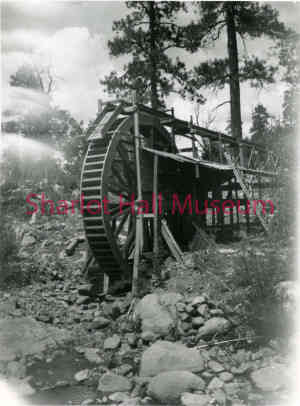Hassayampa River Waterwheel
details
Unknown Unknown 1600.0481.0001.jpg M - 481 B&W 1600-0481-0001 m481pa Print 4x4 Historic Photographs c. 1917 Reproduction requires permission. Digital images property of SHM Library & ArchivesDescription
Water Wheel on the Hassayampa River, c. 1917.
Photograph of an unidentified overshot water wheel, streamside, in Yavapai County, Arizona territory, c. 1900's.
A waterwheel was one of the most important sources of energy. It was invented and used since ancient times. Water wheels were placed next to areas of moving water such as rivers or streams and in canals. They harnessed moving water to generate milling and concentrating machinery. When the flow was sufficient, the water wheel used flowing or falling water to create power by means of paddles or buckets mounted around the wheel. The energy they generated was then re-directed to mechanical devices and other uses where “power” was required.
There were three types of water wheels, including overshot, undershot, and breastshot wheels. Each type of waterwheel operates according to how its' source water interacts with the wheel. Overshot wheels are powered by water flowing over its' top. Undershot wheels are powered by water flowing underneath it. Breastshot wheels are powered by water entering at the side of the wheel. Water wheels were a precursor to modern hydroelectric power generation.
The Hassayampa River is an intermittent river about 113 miles long, with a watershed of 1,410 square miles. Most of the river flows through desert landscape. The river’s headwaters flow from its source outside of Prescott, Arizona, in a southwesterly direction where it eventually meets the Gila River near the unincorporated communities of Hassayampa and Arlington, Arizona.
According to the Western Mining History website, the tributaries of the Hassayampa River drain a wide area of mineralized terrain. The ore deposits that contributed the gold found along the Hassayampa and its tributaries are of both Precambrian and Tertiary age, and it is difficult to demonstrate which vein and vein systems provided the source of the placer gold in the early days of the Arizona Territory.
Purchase
To purchase this image please click on the NOTIFY US button and we will contact you with details
The process for online purchase of usage rights to this digital image is under development. To order this image, CLICK HERE to send an email request for details. Refer to the ‘Usage Terms & Conditions’ page for specific information. A signed “Permission for Use” contract must be completed and returned. Written permission from Sharlot Hall Museum is required to publish, display, or reproduce in any form whatsoever, including all types of electronic media including, but not limited to online sources, websites, Facebook Twitter, or eBooks. Digital files of images, text, sound or audio/visual recordings, or moving images remain the property of Sharlot Hall Museum, and may not be copied, modified, redistributed, resold nor deposited with another institution. Sharlot Hall Museum reserves the right to refuse reproduction of any of its materials, and to impose such conditions as it may deem appropriate. For certain scenarios, the price for personal usage of the digital content is minimal; CLICK HERE to download the specific form for personal usage. For additional information, contact the Museum Library & Archives at 928-445-3122 ext. 14 or email: orderdesk@sharlot.org.




